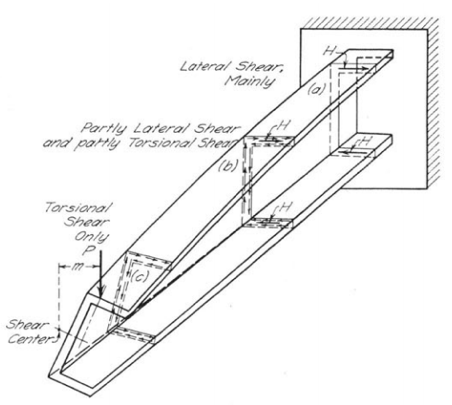cohoman
Aerospace
- Sep 25, 2016
- 37
I'm looking at a cantilever beam with a pure torsion load applied at the free end. From the various references I've read, I understand that at the free end the stress is 100% torsional shear (Saint Venant's torsion). As you move towards the fixed end of the beam, the section stress is partly torsional shear stress and partly due to lateral shear as depicted in the picture below.

Because the flanges at the fixed end of the beam are restrained from warping the torsional stresses can't develop at that end. Instead, the applied torsional load is reacted by lateral shear forces in the flanges of a I-Beam for example, and also in-plane bending moments. I can visualize and understand this concept when looking at a I-Beam section, but what about something simpler like a slender rectangular section?
For a rectangular section of dimensions b and t, Saint Venant's shear stress due to pure torsion is calculated as 3T/(b*t^2). From my description above I understand this is the shear stress at the free end of the beam. What about the fixed end of the beam? For a rectangular section do we have the same shear stress, or is there zero shear stress? If so, how is the torsion load reacted at the fixed end?
Thanks.

Because the flanges at the fixed end of the beam are restrained from warping the torsional stresses can't develop at that end. Instead, the applied torsional load is reacted by lateral shear forces in the flanges of a I-Beam for example, and also in-plane bending moments. I can visualize and understand this concept when looking at a I-Beam section, but what about something simpler like a slender rectangular section?
For a rectangular section of dimensions b and t, Saint Venant's shear stress due to pure torsion is calculated as 3T/(b*t^2). From my description above I understand this is the shear stress at the free end of the beam. What about the fixed end of the beam? For a rectangular section do we have the same shear stress, or is there zero shear stress? If so, how is the torsion load reacted at the fixed end?
Thanks.
